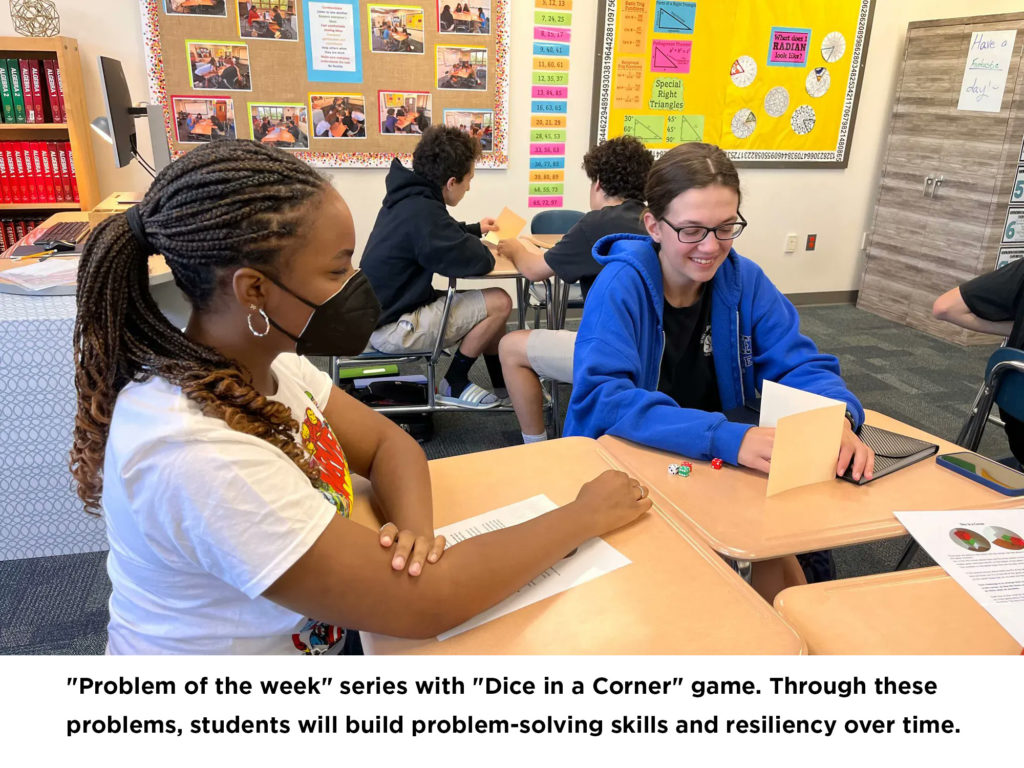Solenne Abaziou, Math Department Chair
Encouraging Persistence in Math

Weekly open-ended math tasks can pique students’ interest, leading them to take risks and develop a growth mindset.
See the original article in Edutopia
Students often struggle with persistence—they’re uncomfortable with the idea of trying a solution if they’re not confident that it will yield the desired results, which leads them to refuse to take risks.
Helping students get past this fear will give them a big advantage in math and in many other areas of daily life. Tasks called “problem solvers” are valuable tools for leading students to persist when faced with difficulties and to develop a growth mindset through productive struggle.
Crafting Rich Problem Solvers
The ideal problem solver has a low floor and high ceiling: The skills needed to tackle the problem should be minimal, to allow weaker students to engage with it, but it should have several levels of complexity, to challenge high-flying students.
The dice in a corner problem from the NRICH Project is a perfect example. This problem asks students to align at least three dice in a corner such that the touching faces have equal value, and the sum of the exposed faces is exactly 18. So the minimum requirement to find a solution is being able to count up to 18, a low floor, but educators can push more capable students by prompting them with questions about patterns they notice or by encouraging them to find all of the solutions.
Open-ended problems allow students to be confused at the beginning, which encourages them to struggle until they get on a path that will likely lead them to the solution. Learning to work through the initial frustration of not knowing where to start is the first step to building problem-solving resilience in students.
It’s helpful when a problem leaves room for different interpretations. A vaguely worded question promotes critical thinking as students decide what they think the question means and how that will affect their solution. Snowmen Buttons by Christian Courtemanche is an example of an ambiguous wording for elementary levels. This problem asks students how many snowmen with two or three buttons each can be built if they have 21 buttons, but it doesn’t specify whether all the buttons must be used or if the number of snowmen should be maximized.
Having multiple solution paths allows students to use their creativity and makes problem solvers accessible to all learning styles. My students recently found seven different ways to approach a problem solver I brought them, and the discussion that came out of it when they explained their reasoning to others helped develop their mathematical communication skills.
Supporting Students to Persevere
Teacher support throughout the problem solver is essential to its success. The most crucial piece is to remove all factors that may inhibit students from thinking outside the box and trying things they’re unsure of. To do this, I take away the expectation that students will solve the problem and I don’t grade the final product.
Instead, we focus on the process, and I give students a participation grade. This has leveled the playing field, as weaker students who are used to struggling through problems have an advantage over their peers who don’t usually need to put in as much effort.
Another important consideration is how to respond to student questions. For me, answering them robs students of learning opportunities. Reflecting them back and encouraging students to answer their own questions teaches them to become resourceful. It’s useful to have several questions ready to help students deepen their thinking as they go along, to take the problem to a higher level if they finish, or to spark ideas in students who get stuck. Examples include “Have you found all of the possible solutions? How do you know?” and “Are there any other ways you can get to the answer?”
To develop mathematical communication skills, students should be encouraged to work together and share their methods with others. Pairing strong and weak students or those with different learning styles is a great way to do this. But allowing students to create their own groups reinforces to them that they are free to proceed as they see fit in this task.
A class discussion at the end in which learners are asked to justify the method they chose emphasizes that any strategy is acceptable as long as there is sound reasoning behind it.
Some Things to Consider
Variety is key to keeping students engaged in problem solvers. Though the problems should encourage deeper thinking, having an easier problem once in a while helps students avoid feeling burnt out.
I also like to vary the types of problems and the content. The problems I give in my algebra class often don’t have an algebra component—like the dice in a corner problem described above—and they never relate to the content we’re currently studying. Problem solvers keep the class fun and engaging.
Doing these tasks on a regular basis is ideal to give students the practice they need and keep them flexing their problem-solving muscles—I generally use a full class period once a week, but any exposure is beneficial. I would caution teachers against judging the success of this activity for at least the first eight times. When I started out, I heard nothing but complaints, and several students didn’t engage with the problems at all for the first few weeks. They gradually came to understand the purpose of the activity, and their complaints turned into “I know this is good for me, but . . . ”
Eventually students would come to class excited to find out what the problem solver of the week was. The lesson in this: Problem solvers teach patience and perseverance not only to students, but also to their teachers.